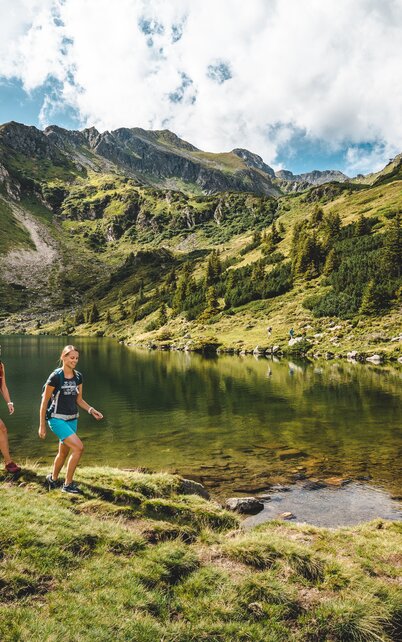Signage in Schladming-Dachstein Step by step through the region: Always on the right track
To help preserve this beauty, it’s important to act responsibly – and that means, above all, staying on the marked trails. Going off-trail not only puts your own safety at risk but can also harm animals, plants, and the landscape.
On this page, we’ve gathered the most important information about staying on the trails, and we also introduce you to the signage systems for hiking, biking, winter hiking, and running in the Schladming-Dachstein region – so you’ll always be on the right path.
in the Schladming-Dachstein region
Signage concepts
The examples shown below represent the unified signage concept currently being implemented throughout the Schladming-Dachstein region. The project was launched in 2024 and is being rolled out step by step, which means it may take some time until all signs across the entire region comply with these standards. However, most of the existing systems currently in use are structured in a similar way and already provide good basic orientation.
Hiking signage
- Sign dimensions: 600 × 150 mm
- Content: 1–3 lines indicating the level of difficulty, destination, walking time or distance, and the trail number.
- Winter suitability: A magenta-colored arrow tip indicates that the route from this point is also accessible in winter. In addition, there is an icon for winter hiking or snowshoeing.
- Winter icons: If a hiking destination is also reachable in winter, the corresponding icon is already displayed in the difficulty section of the sign.
- Distance information: In addition to the destination, an optional distance may be shown, as distances are often more helpful than walking times in winter.
- Reason for winter integration: This approach helps reduce the number of signs and maintenance efforts, as routes that are accessible year-round do not require seasonal installation or removal.
- Footer: Contains the trail operator, location number, location name, and pictograms for circular routes, if applicable.
- Location sign: Displays the location name, altitude, and coordinates. The footer also includes the trail operator, location number, and the alpine emergency number.
Bike signage
In 2024, the Province of Styria introduced a new signage system for cycling. Over the coming years, this system will be implemented on all cycle paths, mountain bike routes, and trails to ensure a consistent concept for visitors throughout the entire province. The concept is also very similar to existing systems in other Austrian provinces, making cross-regional orientation easy and seamless.
Winter hikes (without summer route)
- Winter or snowshoe hiking icon: Indicates whether the route is suitable for winter hiking or snowshoeing.
- Trail operator logo: Identifies the organization responsible for the route and its signage.
- Direction arrow: Shows the direction of travel for the route.
- Destination information: One or more lines indicating destinations and, optionally, the distance (optional for circular routes).
- Location information: Includes the location number and the location name.
Running lap signage
- Trail running/running icon & trail holder logo: At the top of the sign. Additionally, a QR code that leads to the landing page for running routes.
- Direction arrow: Indicates the running direction.
- Running laps: 1 to several lines with their own symbols, the name of the lap and the information "x of y km".
- Location information: Contains the location information and the location number.





